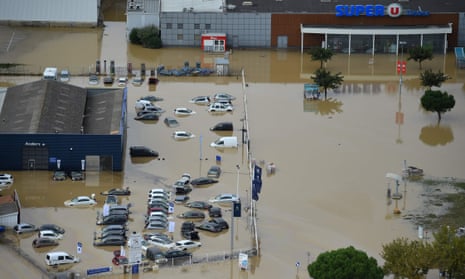Severe floods and other extreme weather have cost Europe about half a trillion euros in the past four decades, with Germany, France and Italy the worst-hit countries.
Between 90,000 and 142,000 deaths were attributed to weather and climate-related events over the period 1980 to 2020, the overwhelming majority of them from heatwaves.
The data, published by the European Environment Agency on Thursday, does not show a clear trend of increase in losses over the decades from the impact of the climate crisis. This is because the economic impacts tend to be concentrated in a few major events – more than 60% of the economic losses came from just 3% of the weather events over the period – and these can strike anywhere and cause vastly different results.
Wouter Vanneuville, of the EEA, one of the lead authors of the study, said: “There is no clear pattern for the most extreme events – they are still random, to a large extent. But adaptation is ongoing and is having an impact.”
He said the fact that losses were not clearly increasing should not make people complacent, but underlined the importance of adapting infrastructure and making preparations for extreme weather, which is likely to become more frequent and intense as the climate crisis progresses and temperatures increase. “The reason we don’t see a trend is not that climate change is not real, but because a lot of actions are going on against climate change. More and more countries are implementing adaptation strategies,” he said.
Countries should invest further in adaptation, he said, as progress on protecting against the effects of the climate crisis varied widely across Europe. “Even if we reach net zero emissions before 2050, adaptation will still be needed to keep the impacts limited,” he said.
The UK has opted out of membership of the EEA, Europe’s environmental watchdog, since Brexit, though other non-EU states such as Norway and Switzerland are members, and the EEA data covers 32 countries of which five are non-EU. However, the UK was a member for the period studied, and its losses were calculated at about €57bn over the period, equivalent to close to €1,000 per person, with 3,500 deaths. About 70% of the economic losses were insured, the highest value of any of the countries.
The worst economic damage was caused by “hydrological” events – largely floods – which accounted for up to 44% of the losses, closely followed by damage from “meteorological” events – mainly storms – which amounted to up to 39%, depending on the dataset used.
The EEA collated the data on economic losses from insurers and other commercial sources which had slightly different methodologies, giving a spread of estimates for the losses over the period of between €450bn and €520bn depending on the datasets used. Just under a quarter (23%) of losses over the period were insured, though these rates varied widely among countries, with more than half of losses insured in Denmark and the Netherlands, and only about 1% in Lithuania and Romania.
Switzerland, Slovenia and France had the highest losses per capita over the period, and the highest losses relative to area were in Switzerland, Germany and Italy.
